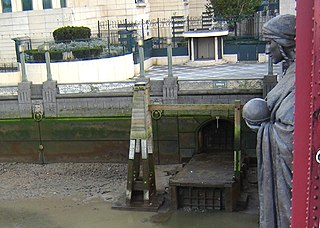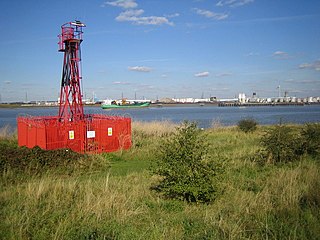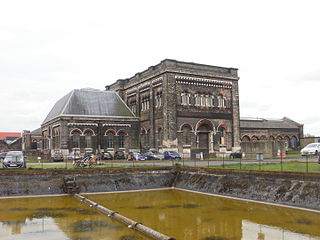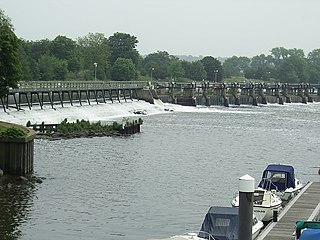Subterranean London refers to a number of subterranean structures that lie beneath London. The city has been occupied by humans for two millennia. Over time, the capital has acquired a vast number of these structures and spaces, often as a result of war and conflict.

The River Effra is a former set of streams in south London, England, culverted and used mainly for storm sewerage. It had been a tributary of the Thames. Its catchment waters, where not drained to aquifer soakaways and surface water drains, have been incorporated into 1850s-built combined sewer sectors, devised by Sir Joseph Bazalgette. One drains Peckham, the other Brixton, then intended to flow towards Peckham. These generally flow east to be treated at Crossness.

Sir Joseph William Bazalgette CB was a 19th-century English civil engineer. As chief engineer of London's Metropolitan Board of Works, his major achievement was the creation of a sewerage system for central London which was instrumental in relieving the city from cholera epidemics, while beginning to clean the River Thames. He was also the designer of Hammersmith Bridge.

The River Ravensbourne is a tributary of the River Thames in south London, England. It flows into the tidal River Thames at Deptford, where its tidal reach is known as Deptford Creek.

The London sewer system is part of the water infrastructure serving London, England. The modern system was developed during the late 19th century, and as London has grown the system has been expanded. It is currently owned and operated by Thames Water and serves almost all of Greater London.

Beckton is a suburb in east London, England, located 8 miles (12.9 km) east of Charing Cross. Part of the London Borough of Newham, a local authority district of Greater London, it was formerly in the historic county of Essex but now lies in the ceremonial county of Greater London.

Abbey Mills Pumping Station is a sewage pumping station in Mill Meads, East London, operated by Thames Water. The pumping station lifts sewage from the London sewerage system into the Northern Outfall Sewer and the Lee Tunnel, which both run to Beckton Sewage Treatment Works.

The Northern Outfall Sewer (NOS) is a major gravity sewer which runs from Wick Lane in Hackney to Beckton sewage treatment works in east London; most of it was designed by Joseph Bazalgette after an outbreak of cholera in 1853 and the "Great Stink" of 1858.

Stamford Brook was a tributary of the Tideway stretch of the River Thames in west London supplied by three headwaters. Historically used as an irrigation ditch or dyke the network of small watercourses had four lower courses and mouths.

The Thames Tideway Tunnel is a 25 km (16 mi) combined sewer under construction running mostly under the tidal section (estuary) of the River Thames across Inner London to capture, store and convey almost all the raw sewage and rainwater that currently overflows into the estuary. These events occur when rainfall volumes exceed the capacity of Bazalgette's and other engineers' London sewerage system. The tunnelling phase of the project was completed in April 2022.

The North Kent Line is a railway line which branches off the South East Main Line at St Johns junction west of Lewisham station in Greater London and runs to Rochester Bridge Junction near Strood, Medway where it links to the Chatham Main Line.

The Great Stink was an event in Central London during July and August 1858 in which the hot weather exacerbated the smell of untreated human waste and industrial effluent that was present on the banks of the River Thames. The problem had been mounting for some years, with an ageing and inadequate sewer system that emptied directly into the Thames. The miasma from the effluent was thought to transmit contagious diseases, and three outbreaks of cholera before the Great Stink were blamed on the ongoing problems with the river.

Crossness is a location in the London Borough of Bexley, close to the southern bank of the River Thames, to the east of Thamesmead, west of Belvedere and north-west of Erith. The place takes its name from Cross Ness, a specific promontory on the southern bank of the River Thames. In maritime terms, the tip of Cross Ness, in the past referred to as 'Leather Bottle Point', marks the boundary between Barking Reach and Halfway Reach. An unmanned lighthouse on Crossness is a navigational aid to shipping.

The Crossness Pumping Station is a former sewage pumping station designed by the Metropolitan Board of Works's chief engineer Sir Joseph Bazalgette and architect Charles Henry Driver. It is located at Crossness Sewage Treatment Works, at the eastern end of the Southern Outfall Sewer and the Ridgeway path in the London Borough of Bexley. Constructed between 1859 and 1865 by William Webster, as part of Bazalgette's redevelopment of the London sewerage system, it features spectacular ornamental cast ironwork, that Nikolaus Pevsner described as "a masterpiece of engineering – a Victorian cathedral of ironwork".

The Tideway is a part of the River Thames in England which is subject to tides. This stretch of water is downstream from Teddington Lock. The Tideway comprises the upper Thames Estuary including the Pool of London.
Bovril boats, also known formally as sludge vessels, were specially designed sewage dumping vessels that operated on the River Thames from 1887 to 1998. Their task was to remove London's human solid waste from Beckton and Crossness for disposal on the ebb tide at sea, at Black Deep, an extremely deep part of the North Sea fifteen miles off Foulness, on one of the main approaches to the Thames Estuary. Similar boats operated on the Manchester Ship Canal, the Tyne, and elsewhere.

The Ridgeway is a 3.5-mile (5.6 km) "cycling permitted pedestrian priority" footpath owned by Thames Water in southeast London. It runs between Plumstead and Crossness on an embankment that covers the Joseph Bazalgette Southern Outfall Sewer.

Beckton Sewage Treatment Works, formerly known as Barking Sewage Works, is a large sewage treatment plant in Beckton in the east London Borough of Newham, operated by Thames Water.
Greenwich Pumping Station, known until circa 1986 as Deptford Pumping Station, is a sewage pumping station in the London Borough of Greenwich built in 1865 to the east of Deptford Creek. It is part of the London sewerage system devised by Sir Joseph Bazalgette in the mid 19th century. Today operated by Thames Water, it is located on the western side of Norman Road, approximately 0.5 km (0.31 mi) south west of Greenwich town centre, on the eastern bank of Deptford Creek, around 0.5 km (0.31 mi) south of its confluence with the River Thames.

The Crossness Sewage Treatment Works is a sewage treatment plant located at Crossness in the London Borough of Greenwich. It was opened in 1865 and is Europe's second largest sewage treatment works, after its counterpart Beckton Sewage Treatment Works located north of the river. Crossness treats the waste water from the Southern Outfall Sewer serving South and South East London, and is operated by Thames Water.

















